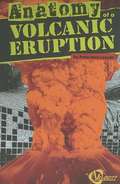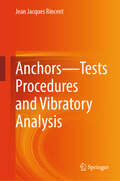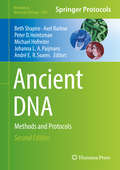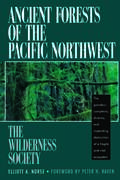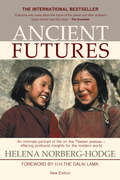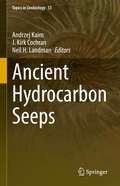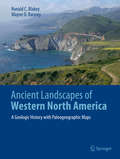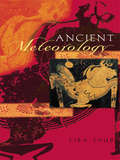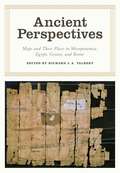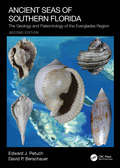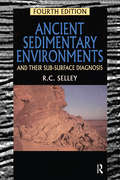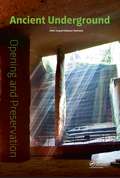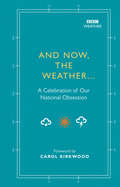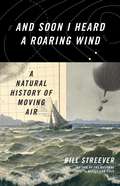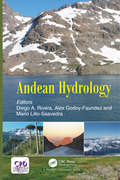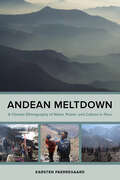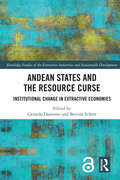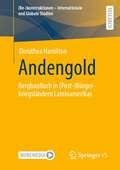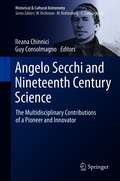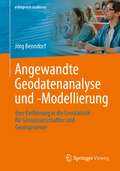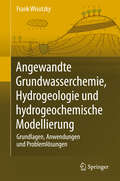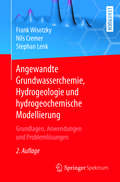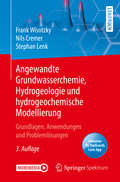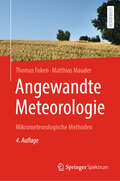- Table View
- List View
Anatomy of a Volcanic Eruption
by Amie Jane LeavittDescribes volcanic eruptions, including their causes, prediction, and effects.
Anchors—Tests Procedures and Vibratory Analysis
by Jean Jacques RincentThis book follows: Ground Anchors: Tension Force Vibratory Analysis JJ Rincent Springer Sept 2024. This new book is a summary of experience gained from the analysis of over 24 000 test curves obtained from 3000 ground anchors analysis. It provides practical feedback on the complexity of non-destructive testing. The test equipment, the rules to obtain interpretable acquisition results. The examples come from trials carried out in Brazil over the last 5 years and finally, the test methodology adopted for this experiment. These tests are generally carried out on ground anchors using strands as reinforcement or rebars several decades old. Information on their length and initial tension force is often non-existent after 40 years. That's why these vibration analysis tests provide the answers and information needed for stability and maintenance diagnostics. The examples chosen concern ground anchors equipped with bars, strands and also for nails, passive ground anchors and micro piles. Tests on prestressed dowels are described, and a test on a reinforcing bar linked to the construction of an early 16th century castle will be carried out. As a reminder that these tests results lead to define the total length of the tie bar, the free length, the diameter of the tie bar, i.e. the reinforcement with its cement grout, and finally the tension force at the time of testing. These data are essential for assessing the stability of retaining walls stabilised by tie rods. It should be stated that static tests, which are difficult to carry out at height, provide no information on lengths and run the risk of breaking old tie rods. All the tests carried out are used to construct the test method that can be adopted, taking into account the feedback acquired from thousands of static tests. For retaining structures and tie rods in particular, access to the head of the tie rods must be preserved in order to: - carry out inspection tests - re-tension the tie rods, if necessary - while protecting them from corrosion. Meeting these conditions means implementing sustainable maintenance of the structures. This test method is a diagnostic tool for ground anchors used by managers of retaining structures to design maintenance projects. The final aim is to increase the durability of the retaining structures. The tests proposed and explained using numerous examples and finally to propose a methodology for carrying out vibration analysis tests on ground anchors, as well as a framework for their interpretation.
Ancient DNA: Methods And Protocols (Methods In Molecular Biology Series #840)
by Michael Hofreiter Beth Shapiro Axel Barlow Peter D. Heintzman Johanna L. A. Paijmans André E. R. SoaresThis fully updated second edition explores protocols that address the most challenging aspects of experimental work in ancient DNA, such as preparing ancient samples for DNA extraction, the DNA extraction itself, and transforming extracted ancient DNA molecules for sequencing library preparation. The volume also examines the analysis of high-throughput sequencing data recovered from ancient specimens, which, because of the degraded nature of ancient DNA and common co-extraction of contaminant DNA, has challenges that are unique compared to data recovered from modern specimens.Written in the highly successful Methods in Molecular Biology series format, chapters include introductions to their respective topics, lists of the necessary materials and reagents, step-by-step, readily reproducible laboratory protocols, and tips on troubleshooting and avoiding known pitfalls. <P><P> Authoritative and cutting-edge, Ancient DNA: Methods and Protocols, Second Edition aims to serve both experts and beginners by presenting protocols in a manner that makes them easily accessible for everyday use in the lab.
Ancient Forests of the Pacific Northwest
by Peter H. Raven The Wilderness Society Elliott A. NorseAncient Forests of the Pacific Northwest provides a global context for what is happening in the Pacific Northwest, analyzing the remaining ancient forest and the threats to it from atmospheric changes and logging. It shows how human tampering affects an ecosystem, and how the Pacific Northwest could become a model for sustainable forestry worldwide.
Ancient Futures, 3rd Edition
by Helena Norberg-Hodge H.H. the Dalai LamaA moving portrait of tradition and change in Ladakh, or “Little Tibet,” Ancient Futures is also a scathing critique of the global economy and a rallying call for economic localization. When Helena Norberg-Hodge first visited Ladakh in 1975, she found a pristine environment, a self-reliant economy and a people who exhibited a remarkable joie de vivre. But then came a tidal wave of economic growth and development. Over the last four decades, this remote Himalayan land has been transformed by outside markets and Western notions of “progress.” As a direct result, a whole range of problems—from polluted air and water to unemployment, religious conflict, eating disorders and youth suicide—have appeared for the first time. Yet this is far from a story of despair. Social and environmental breakdown, Norberg-Hodge argues, are neither inevitable nor evolutionary, but the products of political and economic decisions—and those decisions can be changed. In a new Preface, she presents a kaleidoscope of projects around the world that are pointing the way for both human and ecological well-being. These initiatives are the manifestation of a rapidly growing localization movement, which works to rebuild place-based cultures—strengthening community and our connection with nature. Ancient Futures challenges us to redefine what a healthy economy means, and to find ways to carry centuries-old wisdom into our future. The book and a related film by the same title have, between them, been translated into more than 40 languages.
Ancient Hydrocarbon Seeps (Topics in Geobiology #50)
by Neil H. Landman Andrzej Kaim J. Kirk CochranThis volume details the function of hydrocarbon seeps, their evolution over time, the most important seep occurrences and the fauna present in ancient hydrocarbon seeps. While several publications exist that cover modern seeps and vents, fossil seeps only constitute a small component of the literature. As such, many geologists, stratigraphers and paleontologists, as well as undergraduates and graduate students, are not very familiar with ancient hydrocarbon seep deposits and their associated fauna. This text is the first to comprehensively discuss the nature of such animal groups and how to recognize them. In addition to summarizing available knowledge on these topics for specialists in the field, this book offers the background needed to be of use to students as well as the wider community of geologists and paleontologists.
Ancient Landscapes of Western North America: A Geologic History with Paleogeographic Maps
by Ronald C. Blakey Wayne D. RanneyAllow yourself to be taken back into deep geologic time when strange creatures roamed the Earth and Western North America looked completely unlike the modern landscape. Volcanic islands stretched from Mexico to Alaska, most of the Pacific Rim didn’t exist yet, at least not as widespread dry land; terranes drifted from across the Pacific to dock on Western Americas’ shores creating mountains and more volcanic activity. Landscapes were transposed north or south by thousands of kilometers along huge fault systems. Follow these events through paleogeographic maps that look like satellite views of ancient Earth. Accompanying text takes the reader into the science behind these maps and the geologic history that they portray. The maps and text unfold the complex geologic history of the region as never seen before.
Ancient Meteorology (Sciences of Antiquity)
by Liba TaubThe first book of its kind in English, Ancient Meteorology discusses Greek and Roman approaches and attitudes to this broad discipline, which in classical antiquity included not only 'weather', but occurrences such as earthquakes and comets that today would be regarded as geological, astronomical or seismological. The range and diversity of this literature highlights the question of scholarly authority in antiquity and illustrates how writers responded to the meteorological information presented by their literary predecessors. Ancient Meteorology will be a valuable reference tool for classicists and those with an interest in the history of science.
Ancient Perspectives: Maps and Their Place in Mesopotamia, Egypt, Greece and Rome
by Richard J. A. TalbertAncient Perspectives encompasses a vast arc of space and time--Western Asia to North Africa and Europe from the third millennium BCE to the fifth century CE--to explore mapmaking and worldviews in the ancient civilizations of Mesopotamia, Egypt, Greece, and Rome. In each society, maps served as critical economic, political, and personal tools, but there was little consistency in how and why they were made. Much like today, maps in antiquity meant very different things to different people. Ancient Perspectives presents an ambitious, fresh overview of cartography and its uses. The seven chapters range from broad-based analyses of mapping in Mesopotamia and Egypt to a close focus on Ptolemy's ideas for drawing a world map based on the theories of his Greek predecessors at Alexandria. The remarkable accuracy of Mesopotamian city-plans is revealed, as is the creation of maps by Romans to support the proud claim that their emperor's rule was global in its reach. By probing the instruments and techniques of both Greek and Roman surveyors, one chapter seeks to uncover how their extraordinary planning of roads, aqueducts, and tunnels was achieved. Even though none of these civilizations devised the means to measure time or distance with precision, they still conceptualized their surroundings, natural and man-made, near and far, and felt the urge to record them by inventive means that this absorbing volume reinterprets and compares.
Ancient Seas of Southern Florida: The Geology and Paleontology of the Everglades Region
by Edward J. Petuch David P. BerschauerThe authors have done an outstanding job of compiling decades of data collected by their own field reconnaissance and other geoscientists… This represents a significant contribution to the understanding of the development of the Florida carbonate platform, and it will assist other disciplines as they strive for better understanding of our groundwater resources, aquifer characterizations, paleoenvironmental interpretations, and historical/educational geology programs.Walt Schmidt, Florida State Geologist & Chief, Florida Geological Survey, USA (praise for the first edition)Painting a complete picture of the history of the Everglades, Ancient Seas of Southern Florida: The Geology and Paleontology of the Everglades Region, Second Edition provides an overview of the geology, paleontology, and paleoceanography of the region. It emphasizes the upper 300m of the geologic framework of the area and gives insight into the local stratigraphy, geomorphology, lithology, and historical geology. Designed to be a field guide as well as a reference, the book is illustrated in full color with brand new photographs of exposed geologic sections, stratotype localities, collection sites, and details of interesting fossil beds.In this book, the authors illustrate almost 800 of the most important and diagnostic stratigraphic index fossils found in these beds, including over 50 species of corals and almost 700 species of mollusks, along with echinoderms, crustaceans, echinoids, petrified wood, and aquatic vertebrates. A new edition of The Geology of the Everglades and Adjacent Areas, it contains larger images of fossil shells, corals, and echinoderms and includes new updated geological data and concepts, as well as an expanded iconography of stratigraphic index fossils. Based on the data gleaned from these fossils, it also offers a series of geomorphological visualizations, showing the possible appearances of the Florida Peninsula during the times when it was covered by tropical seas, from the Oligocene to the late Pleistocene.This second edition provides a new perspective on both the historical geology of southern Florida and the evolution of one of America’s most beautiful natural treasures, the Everglades.
Ancient Sedimentary Environments: And Their Sub-surface Diagnosis
by Selley, Richard C.This edition retains the case history approach to emphasize the subsurface diagnosis of environments using seismic and geophysical well logs and their application to petroleum exploration and production. This book should be of interest to undergraduates in sedimentology and petroleum geology.
Ancient Underground Opening and Preservation: Proceedings of the International Symposium on Scientific Problems and Long-term Preservation of Large-scale Ancient Underground Engineering (23-26 October 2015, Longyou, Zhejiang, China)
by Zhifa Yang Chikaosa TanimotoAncient Underground Opening and Preservation contains 59 papers presented at the International Symposium on Scientific Problems and Long-term Preservation of Largescale Ancient Underground Engineering (Longyou, China, 23-26 October 2015). The contributions focus on scientific and technical issues related to long-term preservation of large-scale anc
And Now, The Weather...: A celebration of our national obsession
by Alison MaloneyAlong with the fine art of queuing and proper tea, talking about the weather is the essence of Britishness. We’re all a little bit obsessed by it. Will it snow this Christmas? Was this year really the warmest on record? And where on earth did ‘raining cats and dogs’ come from? According to recent research, 94% of British people admit to having discussed the weather in the past six hours, while 38% say they have in the past 60 minutes. And Now, The Weather... is an almanac, a miscellany, and a celebration of our most famous obsession. Including beautiful illustrations, maps and line drawings, And Now, The Weather... is a perfect gift for the cloudspotter in your life.Features include:- The Lore of Weather – myths, legends and old wives tales about the weather.- Lost in Translation – Colloquial names for weather around the country, from Custard Winds to Mizzle. - Extreme Weather – Bizarre events in the history of British Weather including red rain and a downpour of frogs and fish.- Plus tables showing record breaking sunshine, wind speed, rainfall, heat etc.
And Soon I Heard a Roaring Wind: A Natural History of Moving Air
by Bill StreeverA thrilling exploration of the science and history of wind from the bestselling author of Cold.Scientist and bestselling nature writer Bill Streever goes to any extreme to explore wind--the winds that built empires, the storms that wreck them--by traveling right through it. Narrating from a fifty-year-old sailboat, Streever leads readers through the world's first forecasts, Chaos Theory, and a future affected by climate change. Along the way, he shares stories of wind-riding spiders, wind-sculpted landscapes, wind-generated power, wind-tossed airplanes, and the uncomfortable interactions between wind and wars, drawing from natural science, history, business, travel, as well as from his own travels. AND SOON I HEARD A ROARING WIND is an effortless personal narrative featuring the keen observations, scientific rigor, and whimsy that readers love. You'll never see a breeze in the same light again.
Andean Hydrology
by Diego A. Rivera Alex Godoy-Faundez Mario Lillo SaavedraThis book describes the ecosystem of the Andean watersheds, covering the Californian valley, tropical Andes, and southern Andes. Case studies of the new methods and techniques used for hydrological research in the Andes are provided, and sustainability issues pertaining to Andean water resources are discussed in the context of climate change, social and economic issues, and public policy. Furthermore, the impact of economic development on the Andean ecosystem, specifically the effect on the water cycle and the water-energy-food nexus, are examined.
Andean Meltdown: A Climate Ethnography of Water, Power, and Culture in Peru
by Karsten PaerregaardAndean Meltdown examines how climate change and its consequences for Peru's glaciers are affecting the country's water supply and impacting Andean society and culture in unprecedented ways. Drawing on forty years of extensive research, relationship building, and community engagement in Peru, Karsten Paerregaard provides an ethnographic exploration of Andean ritual practices and performances in the context of an altered climate. By documenting Andean peoples' responses to rapid glacier retreat and urgent water shortages, Paerregaard considers the myriad ways climate change intersects with environmental, social, and political change. A pathbreaking contribution to cultural anthropology and environmental humanities, Andean Meltdown challenges prevailing theoretical thinking about the culture-nature nexus and offers a new perspective on Andean peoples' understanding of their role as agents in the shifting relationship between humans and nonhumans.
Andean States and the Resource Curse: Institutional Change in Extractive Economies (Routledge Studies of the Extractive Industries and Sustainable Development)
by Gerardo Damonte Bettina SchorrThis volume explores institutional change and performance in the resource-rich Andean countries during the last resource boom and in the early post-boom years. The latest global commodity boom has profoundly marked the face of the resource-rich Andean region, significantly contributing to economic growth and notable reductions of poverty and income inequality. The boom also constituted a period of important institutional change, with these new institutions sharing the potential of preventing or mitigating the maladies extractive economies tend to suffer from, generally denominated as the “resource curse”. This volume explores these institutional changes in the Andean region to identify the factors that have shaped their emergence and to assess their performance. The interdisciplinary and comparative perspective of the chapters in this book provide fine-grained analyses of different new institutions introduced in the Andean countries and discusses their findings in the light of the resource curse approach. They argue that institutional change and performance depend upon a much larger set of factors than those generally identified by the resource curse literature. Different, domestic and external, economic, political and cultural factors such as ideological positions of decision-makers, international pressure or informal practices have shaped institutional dynamics in the region. Altogether, these findings emphasize the importance of nuanced and contextualized analysis to better understand institutional dynamics in the context of extractive economies. This book will be of great interest to students and scholars of the extractive industries, natural resource management, political economics, Latin American studies and sustainable development.
Andengold: Bergbaufluch in (Post-)Bürgerkriegsländern Lateinamerikas ((Re-)konstruktionen - Internationale und Globale Studien)
by Dorothea HamiltonDer 2016 unterschriebene Friedensvertrag mit FARC in Kolumbien stellt das Land u.a. vor die Frage, welche Bedeutung der Ressourcenreichtum des Landes für den Aufbau einer friedlichen Gesellschaft spielen soll. Abgeleitet von den Erkenntnissen aus Peru wird untersucht, welchen Einfluss der legale und nicht legale Abbau von Gold auf die jeweiligen bewaffneten Konflikte hatte, wie sich deren Nutzung in der Friedenszeit wandelte und welche neuen Konflikte entstanden sind. Zum Umgang mit der ehemaligen Konfliktressource Gold gibt es divergierende Vorstellungen, die extraktivistischen und postextraktivstischen Ideen zugeordnet werden können, die in lokalen Konflikten enden. Der Fokus liegt auf der subnationalen, nach Abbauart differenzierten Untersuchung von Ressourcenausbeutung und Bürgerkrieg bzw. Postbürgerkrieg. Die Ergebnisse zu illegalem Bergbau zeigen, dass es sich dabei nicht um ein Bürgerkriegsphänomen handelt, sondern vielmehr um eine geduldete Praxis, die die Bewaffnung von Gewaltakteuren bedingt. Aber auch legale Ressourcenförderung, die nach Beendigung des Konflikts als Strategie der Friedensfinanzierung verstanden wird, führt zu ähnlichen negativen Auswirkungen, sodass von einem Bergbaufluch gesprochen wird.
Andes: On My Grandfather's Trail In Chile And Bolivia
by Michael JacobsFor centuries, the Andes have caught the imagination of travelers, inspiring fear and wonder. The groundbreaking scientist Alexander von Humboldt claimed that "everything here is grander and more majestic than in the Swiss Alps, the Pyrenees, the Carpathians, the Apennines, and all other mountains I have known." Rivaled in height only by the Himalayas and stretching more than 4,500 miles, the sheer immensity of the Andes is matched by its concentration of radically contrasting scenery and climates, and the rich and diverse cultures of the people who live there. In this remarkable book, travel writer Michael Jacobs journeys across seven different countries, from the balmy Caribbean to the inhospitable islands of the Tierra del Fuego, through the relics of ancient civilizations and the remnants of colonial rule, retracing the footsteps of previous travelers. His route begins in Venezuela, following the path of the great nineteenth-century revolutionary Simón Bolívar, but soon diverges to include accounts from sources as varied as Humboldt, the young Charles Darwin, and Bolívar's extraordinary and courageous mistress, Manuela Saenz. On his way, Jacobs uncovers the stories of those who have shared his fascination and discovers the secrets of a region steeped in history, science, and myth.
Angelo Secchi and Nineteenth Century Science: The Multidisciplinary Contributions of a Pioneer and Innovator (Historical & Cultural Astronomy)
by Guy Consolmagno Ileana ChinniciAngelo Secchi was a key figure in 19th century science. An Italian Jesuit and scientist, he helped lead the transition from astronomy to astrophysics and left a lasting legacy in the field. Secchi’s spectral classification of stars was a milestone that paved the way for modern astronomical research. He was also a founder of modern meteorology and an innovator in the design and development of new instruments and methods across disciplines.This contributed volume collects together reviews from an international group of historians, scientists and scholars representing the multiple disciplines where Secchi made significant contributions during his remarkable career. It analyzes both his famous and lesser known pioneering efforts with equal vigor, providing a well-rounded narrative of his life’s work. Beyond his scientific and technological work, his role as a Jesuit priest in Rome during the turbulent years of the mid 19th century is also described and placed in the context of his scientific and civic activities.
Angewandte Geodatenanalyse und -Modellierung: Eine Einführung in die Geostatistik für Geowissenschaftler und Geoingenieure (erfolgreich studieren)
by Jörg BenndorfDie Fähigkeit, räumlich verteilte Daten zu analysieren und die darunterliegenden Prozesse und Strukturen zu verstehen und zu modellieren, ist in vielen Anwendungen der Geowissenschaften und des Geoingenieurwesens maßgebende Grundlage für weiterführende Arbeiten in der Erkenntnisgewinnung oder Planung/Projektierung. Das Fachgebiet der Geostatistik stellt dazu einen umfangreichen Pool an Methoden zur Verfügung, der sich fortwährend erweitert. Das vorliegende Buch ermöglicht sowohl dem Studierenden als auch dem Praktiker einen intuitiven Einstieg in die Grundlagen, Methoden und Anwendungen der Geostatistik. Dabei liegt der Fokus auf einer kurzen und prägnanten Darstellung von Schlüsselkonzepten, der kritischen Diskussion von Annahmen und Limitationen sowie der Illustration von Anwendungen anhand ausgewählter praktischer Beispiele. Übungsaufgaben bieten die Möglichkeit zur Vertiefung des Verständnisses sowie zur Selbstüberprüfung. An entsprechenden Textstellen sind Hinweise zu weiterführender Literatur gegeben. Nach erfolgreichem Studium des Buches gelingt es dem Leser, sich selbstständig in fortgeschrittene Aspekte der angewandten Geostatistik einzuarbeiten.
Angewandte Grundwasserchemie, Hydrogeologie und hydrogeochemische Modellierung: Grundlagen, Anwendungen und Problemlösungen
by Frank WisotzkyNeben den Anwendungen der Grundlagen der anorganischen Wasserchemie wird in dem Band erstmalig zusammenhängend die organische Wasserchemie von Grundwasserbelastungsstoffen behandelt. Darüber hinaus enthält er eine Einführung in die hydrochemische Modellierung und auch die chemischen Aspekte der Wasseraufbereitung werden dargestellt. Viele Beispiele aus der Praxis, Abbildungen und Schemazeichnungen machen die Grundwasserchemie nachvollziehbar und transparent. Mit zahlreichen Übungsaufgaben und dazugehörigen Lösungen.
Angewandte Grundwasserchemie, Hydrogeologie und hydrogeochemische Modellierung: Grundlagen, Anwendungen und Problemlösungen
by Frank Wisotzky Nils Cremer Stephan LenkNeben den Anwendungen der Grundlagen der anorganischen Wasserchemie wird in dem Band erstmalig zusammenhängend die organische Wasserchemie von Grundwasserbelastungsstoffen behandelt. Darüber hinaus enthält er eine Einführung in die hydrochemische Modellierung und auch die chemischen Aspekte der Wasseraufbereitung werden dargestellt. Viele Beispiele aus der Praxis, Abbildungen und Schemazeichnungen machen die Grundwasserchemie nachvollziehbar und transparent. Mit zahlreichen Übungsaufgaben und dazugehörigen Lösungen.
Angewandte Grundwasserchemie, Hydrogeologie und hydrogeochemische Modellierung: Grundlagen, Anwendungen und Problemlösungen
by Frank Wisotzky Nils Cremer Stephan LenkNeben den Anwendungen der Grundlagen der anorganischen Wasserchemie wird in dem Band erstmalig zusammenhängend die organische Wasserchemie von Grundwasserbelastungsstoffen behandelt. Darüber hinaus enthält er eine Einführung in die hydrochemische Modellierung und auch die chemischen Aspekte der Wasseraufbereitung werden dargestellt. Viele Beispiele aus der Praxis, Abbildungen und Schemazeichnungen machen die Grundwasserchemie nachvollziehbar und transparent. Mit zahlreichen Übungsaufgaben und dazugehörigen Lösungen.
Angewandte Meteorologie: Mikrometeorologische Methoden
by Thomas Foken Matthias MauderGegenstand des Buches sind die atmosphärischen Vorgänge im unmittelbaren Lebensraum des Menschen, also in den unteren 100 –1000 Metern der Atmosphäre und in Gebieten mit nur einigen Kilometern Ausdehnung. Dieser mikrometeorologische Raum wird in Büchern der allgemeinen Meteorologie nur wenig berücksichtigt. Damit bietet das Buch Grundlagen insbesondere für angewandte meteorologische Fachgebiete wie Biometeorologie, Agrarmeteorologie, Hydrometeorologie, Umweltmeteorologie und technische Meteorologie sowie für die Biogeochemie. Ein wichtiger Schwerpunkt sind dabei die Transportprozesse und Stoffflüsse zwischen Atmosphäre und Erdoberfläche, wobei bewachsene und heterogene Unterlagen eine besondere Beachtung finden.Die Autoren behandeln die Teilgebiete Theorie, Messtechnik, experimentelle Verfahren und Modellierung so, dass sie jeweils auch eigenständig für Lehre, Forschung und Praxis genutzt werden können.Neuerungen gegenüber der dritten Auflage sind Aktualisierungen und kleinere Ergänzungen in allen Kapiteln sowie ausgewählte inhaltliche Erweiterungen unter Berücksichtigung der Fragen des Klimawandels.
